Unlocking the Linear Lock-In: Mapping Research on Barriers to Transition
Abstract
:1. Introduction
2. Theoretical Background and Conceptual Model
- Consumers buying used goods from other consumers (transfer of ownership, C2C)
- Consumers donating used goods to other consumers (transfer of ownership)
- Companies offering services instead of products (temporary access to goods/pay-per-use)
- Consumers granting access to their private assets to other consumers (C2C) mediated by the internet (peer-to-peer sharing).
- RO1. Classify the studies according to their different contexts;
- RO2. Provide a searchable database for future more focused reviews; and,
- RO3. Obtain a clearer overview of the literature on barriers regarding CE, SE, CC, and PSS.
- RQ: What are the publication trends with regard to barriers to the paradigms of CE, SE, CC, and PSS?
- RQ: Which are the dominant research paradigms and circular strategies in the literature to date in relation to barriers?
- RQ: What research approaches, methods, and sources of data have been used to identify barriers?
- RQ: How have barriers been conceptualised (the epistemological basis) in the literature?
- RQ: What is the contextual framing of barriers in relation to the level of analysis (e.g. industrial sector)?
3. Materials and Methods
3.1. Systematic Mapping
3.2. Protocol
3.2.1. Search Engine
3.2.2. Search String
3.2.3. Search Results
3.2.4. Screening of abstracts for inclusion and exclusion
- the main topic was not about circular economy, product-service system, sharing economy, or collaborative consumption (false positive);
- they were not about barriers (false positive);
- no abstract was available.
3.3. Meta-data Extraction and Classification Scheme
3.4. Synthesis
4. Results
4.1. Article Publication Trends
4.2. Dominant Paradigms and Circular Strategies
4.3. Methods Used by the Studies
4.4. Barriers Identification
4.5. Barriers Context
5. Discussion
Limitations
6. Conclusions
Supplementary Materials
Author Contributions
Funding
Conflicts of Interest
Appendix A
| Category | Definition | Classification Scheme |
|---|---|---|
| Research paradigm | The body of literature or research paradigm that the study addresses or belongs to | Circular Economy, Sharing Economy, etc. |
| Core strategy | The circular strategy that is addressed in the paper | Remanufacturing, Recycling, etc. |
| Publication type | Outlet of the publication | Journal, conference, etc. |
| Type of study | Characteristics of the research approach | Empirical, Conceptual, Literature review, Systematic Literature Review (SLR) |
| Research approach | Chosen design for conducting the research | Qualitative, Quantitative, Theoretical analysis, Mixed |
| Research method | Chosen method for data collection | Interviews, Survey, Focus group, etc. |
| Data source | Data collected specifically for the particular study or not | Primary, Secondary, Combined |
| Barrier focus | If barriers are addressed explicitly as the core focus of the paper | Barriers are/are not the focus |
| Barrier context | The way barriers are contextualised, e.g. as an empirical finding or as background | Empirically identified, Indirectly mentioned, etc. |
| No. barriers | Number of barriers listed | 0, 1, more than one |
| Level of analysis | Location, size or scale of the implied research target | Business model, City scale, User/Individual, etc. |
| Sector, industry or product | If the study is grounded in a certain sector, industry or product | Energy and infrastructure, Packaging, etc. |
| Human development | If the study explicitly relates to a certain HDI | Developed countries, Developing countries |
| Geographical context | If a certain geographical region is specified | Europe, Asia, Africa, etc. |
| Country | If a certain country is specified | Sweden, Germany, etc. |
| Suggestion for the SLR | Suggestion for inclusion in a full systematic literature review | Select, Exclude, Not sure. |
| Notes | Free text, for notetaking and discussion | - |
References
- De Jesus, A.; Mendonça, S. Lost in Transition? Drivers and Barriers in the Eco-innovation Road to the Circular Economy. Ecol. Econ. 2018, 145, 75–89. [Google Scholar] [CrossRef]
- Laurenti, R.; Singh, J.; Cotrim, J.M.; Toni, M.; Sinha, R. Characterizing the Sharing Economy State of the Research: A Systematic Map. Sustainability 2019, 11, 5729. [Google Scholar] [CrossRef] [Green Version]
- Ehrenfeld, J.R. Industrial ecology: A framework for product and process design. J. Clean. Prod. 1997, 5, 87–95. [Google Scholar] [CrossRef]
- Ehrenfeld, J.R. Industrial Ecology: Paradigm Shift or Normal Science? Am. Behav. Sci. 2000, 44, 229–244. [Google Scholar] [CrossRef]
- Arekrans, J.; Ritzén, S.; Laurenti, R.; Sopjani, L. Analysis of Innovation Management Issues in Barriers to Circular Economy. In Proceedings of the CINet—Innovating in An Era of Continuous Disruption, Odense, Denmark, 8–10 September 2019. [Google Scholar]
- Geyer, R.; Jambeck, J.R.; Law, K.L. Production, use, and fate of all plastics ever made. Sci. Adv. 2017, 3, e1700782. [Google Scholar] [CrossRef] [Green Version]
- Korhonen, J.; Nuur, C.; Feldmann, A.; Birkie, S.E. Circular economy as an essentially contested concept. J. Clean. Prod. 2018, 175, 544–552. [Google Scholar] [CrossRef]
- Robèrt, K.-H.; Schmidt-Bleek, B.; De Larderel, J.A.; Basile, G.; Jansen, J.; Kuehr, R.; Thomas, P.P.; Suzuki, M.; Hawken, P.; Wackernagel, M. Strategic sustainable development — selection, design and synergies of applied tools. J. Clean. Prod. 2002, 10, 197–214. [Google Scholar] [CrossRef]
- Veleva, V.; Bodkin, G. Corporate-entrepreneur collaborations to advance a circular economy. J. Clean. Prod. 2018, 188, 20–37. [Google Scholar] [CrossRef]
- Kirchherr, J.; Piscicelli, L.; Bour, R.; Kostense-Smit, E.; Müller, J.; Huibrechtse-Truijens, A.; Hekkert, M. Barriers to the Circular Economy: Evidence from the European Union (EU). Ecol. Econ. 2018, 150, 264–272. [Google Scholar] [CrossRef] [Green Version]
- Rizos, V.; Behrens, A.; Kafyeke, T.; Hirschnitz-Garbers, M.; Ioannou, A. The Circular Economy: Barriers and Opportunities for SMEs. Available online: https://www.ceps.eu/publications/circular-economy-barriers-and-opportunities-smes (accessed on 30 January 2020).
- Vermunt, D.; Negro, S.; Verweij, P.; Kuppens, D.; Hekkert, M. Exploring barriers to implementing different circular business models. J. Clean. Prod. 2019, 222, 891–902. [Google Scholar] [CrossRef] [Green Version]
- Ranta, V.; Aarikka-Stenroos, L.; Ritala, P.; Mäkinen, S.J. Exploring institutional drivers and barriers of the circular economy: A cross-regional comparison of China, the US, and Europe. Resour. Conserv. Recycl. 2018, 135, 70–82. [Google Scholar] [CrossRef]
- Masi, D.; Day, S.; Godsell, J. Supply Chain Configurations in the Circular Economy: A Systematic Literature Review. Sustainability 2017, 9, 1602. [Google Scholar] [CrossRef] [Green Version]
- Camacho-Otero, J.; Boks, C.; Pettersen, I.N. Consumption in the Circular Economy: A Literature Review. Sustainability 2018, 10, 2758. [Google Scholar] [CrossRef] [Green Version]
- Ghisellini, P.; Cialani, C.; Ulgiati, S. A review on circular economy: The expected transition to a balanced interplay of environmental and economic systems. J. Clean. Prod. 2016, 114, 11–32. [Google Scholar] [CrossRef]
- Govindan, K.; Hasanagic, M. A systematic review on drivers, barriers, and practices towards circular economy: A supply chain perspective. Int. J. Prod. Res. 2018, 56, 278–311. [Google Scholar] [CrossRef]
- Liu, J.; Feng, Y.; Zhu, Q.; Sarkis, J. Green supply chain management and the circular economy. Int. J. Phys. Distrib. Logist. Manag. 2018, 48, 794–817. [Google Scholar] [CrossRef]
- Hira, A.; Reilly, K. The Emergence of the Sharing Economy: Implications for Development. J. Dev. Soc. 2017, 33, 175–190. [Google Scholar] [CrossRef]
- Sposato, P.; Preka, R.; Cappellaro, F.; Cutaia, L. Sharing Economy and Circular Economy. How Technology and Collaborative Consumption Innovations Boost Closing the Loop Strategies. Environ. Eng. Manag. J. 2017, 16, 1797–1806. [Google Scholar] [CrossRef]
- Gomez, L.; Pasa, C. The influence of cultural factors in the implementation of product-service systems. In Proceedings of the 14th International Conference on Engineering Design, ICED, Stockholm, Sweden, 19–21 August 2003. [Google Scholar]
- Pessôa, M.V.P.; Becker, J.M.J. Overcoming the Product-Service Model Adoption Obstacles. Procedia CIRP 2017, 64, 163–168. [Google Scholar] [CrossRef]
- Shi, V.G.; Baines, T.; Baldwin, J.; Ridgway, K.; Petridis, P.; Bigdeli, A.Z.; Uren, V.; Andrews, D. Using gamification to transform the adoption of servitization. Ind. Mark. Manag. 2017, 63, 82–91. [Google Scholar] [CrossRef]
- Korhonen, J.; Honkasalo, A.; Seppälä, J. Circular Economy: The Concept and its Limitations. Ecol. Econ. 2018, 143, 37–46. [Google Scholar] [CrossRef]
- Lieder, M.; Rashid, A. Towards circular economy implementation: A comprehensive review in context of manufacturing industry. J. Clean. Prod. 2016, 115, 36–51. [Google Scholar] [CrossRef]
- Zhang, X.; Li, L.; Fan, E.; Xue, Q.; Bian, Y.; Wu, F.; Chen, R. Toward sustainable and systematic recycling of spent rechargeable batteries. Chem. Soc. Rev. 2018, 47, 7239–7302. [Google Scholar] [CrossRef]
- Asif, F.M.; Roci, M.; Lieder, M.; Rashid, A.; Stimulak, M.; Halvordsson, E.; De Bruijckere, R. A practical ICT framework for transition to circular manufacturing systems. Procedia CIRP 2018, 72, 598–602. [Google Scholar] [CrossRef]
- Baxter, W.; Aurisicchio, M.; Childs, P. Contaminated Interaction: Another Barrier to Circular Material Flows. J. Ind. Ecol. 2017, 21, 507–516. [Google Scholar] [CrossRef]
- Galvão, G.D.A.; De Nadae, J.; Clemente, D.H.; Chinen, G.; De Carvalho, M.M. Circular Economy: Overview of Barriers. Procedia CIRP 2018, 73, 79–85. [Google Scholar] [CrossRef]
- Pinheiro, M.A.P.; Seles, B.M.R.P.; De Camargo Fiorini, P.; Jugend, D.; Lopes de Sousa Jabbour, A.B.; da Silva, H.M.R.; Latan, H. The role of new product development in underpinning the circular economy: A systematic review and integrative framework. Manag. Decis. 2019, 57, 840–862. [Google Scholar] [CrossRef]
- Kirchherr, J.; Reike, D.; Hekkert, M. Conceptualizing the circular economy: An analysis of 114 definitions. Resour. Conserv. Recycl. 2017, 127, 221–232. [Google Scholar] [CrossRef]
- Curtis, S.K.; Lehner, M. Defining the Sharing Economy for Sustainability. Sustainability 2019, 11, 567. [Google Scholar] [CrossRef] [Green Version]
- Botsman, R.; Rogers, R. What’s Mine Is Yours: How Collaborative Consumption is Changing the Way We Live; HarperCollins Publishers: New York, NY, USA, 2011; ISBN 9780061963551. [Google Scholar]
- Frenken, K.; Schor, J. Putting the sharing economy into perspective. Environ. Innov. Soc. Transitions 2017, 23, 3–10. [Google Scholar] [CrossRef]
- Tukker, A. Product services for a resource-efficient and circular economy—A review. J. Clean. Prod. 2015, 97, 76–91. [Google Scholar] [CrossRef]
- Baines, T.S.; Lightfoot, H.W.; Evans, S.; Neely, A.D.; Greenough, R.; Peppard, J.; Roy, R.; Shehab, E.; Braganza, A.; Tiwari, A.; et al. State-of-the-art in product-service systems. Proc. Inst. Mech. Eng. Part B: J. Eng. Manuf. 2007, 221, 1543–1552. [Google Scholar] [CrossRef] [Green Version]
- Kjaer, L.L.; Pigosso, D.C.A.; Niero, M.; Bech, N.M.; McAloone, T.C. Product/Service-Systems for a Circular Economy: The Route to Decoupling Economic Growth from Resource Consumption? J. Ind. Ecol. 2018, 23, 22–35. [Google Scholar] [CrossRef] [Green Version]
- Laurenti, R.; Singh, J.; Frostell, B.; Sinha, R.; Binder, C.R. The Socio-Economic Embeddedness of the Circular Economy: An Integrative Framework. Sustainability 2018, 10, 2129. [Google Scholar] [CrossRef] [Green Version]
- Sinha, R.; Laurenti, R.; Singh, J.; Malmström, M.E.; Frostell, B. Identifying ways of closing the metal flow loop in the global mobile phone product system: A system dynamics modeling approach. Resour. Conserv. Recycl. 2016, 113, 65–76. [Google Scholar] [CrossRef] [Green Version]
- Rumelt, R. Good Strategy, Bad Strategy: The Difference and Why It Matters; Crown Business: New York, NY, USA, 2011. [Google Scholar]
- van Eck, N.J.; Waltman, L. Software survey: VOSviewer, a computer program for bibliometric mapping. Scientometrics 2010, 84, 523–538. [Google Scholar] [CrossRef] [Green Version]
- James, K.L.; Randall, N.P.; Haddaway, N.R. A methodology for systematic mapping in environmental sciences. Environ. Évid. 2016, 5, 245. [Google Scholar] [CrossRef] [Green Version]
- Clapton, J.; Rutter, D.; Sharif, N. SCIE Systematic mapping guidance. 2009. Available online: https://www.scie.org.uk/publications/researchresources/rr03.pdf (accessed on 28 January 2020).
- Petersen, K.; Vakkalanka, S.; Kuzniarz, L. Guidelines for conducting systematic mapping studies in software engineering: An update. Inf. Softw. Technol. 2015, 64, 1–18. [Google Scholar] [CrossRef]
- Petersen, K.; Feldt, R.; Mujtaba, S.; Mattsson, M. Systematic mapping studies in software engineering. In Proceedings of the EASE’08 the 12th International Conference on Evaluation and Assessment in Software Engineering; CS Learning & Development Ltd.: Swindon, UK, 2008; Available online: http://www.robertfeldt.net/publications/petersen_ease08_sysmap_studies_in_se.pdf (accessed on 28 January 2020).
- Okoli, C.; Schabram, K. A Guide to Conducting a Systematic Literature Review of Information Systems Research. Available online: https://pdfs.semanticscholar.org/31dc/753345d5230e421ea817dd7dcdd352e87ea2.pdf (accessed on 28 January 2020).
- Denyer, D.; Tranfield, D. Producing a Systematic Review. In The Sage Handbook of Organizational Research Methods; Sage Publications Ltd.: Thousand Oaks, CA, USA, 2009; pp. 671–689. [Google Scholar]
- Xiao, Y.; Watson, M. Guidance on Conducting a Systematic Literature Review. J. Plan. Educ. Res. 2019, 39, 93–112. [Google Scholar] [CrossRef]
- Fink, A. Conducting Research Literature Reviews: From the Internet to Paper; Sage Publications Ltd.: Thousand Oaks, CA, USA, 2014; ISBN 978-1-483-30103-7. [Google Scholar]
- Fahimnia, B.; Sarkis, J.; Davarzani, H. Green supply chain management: A review and bibliometric analysis. Int. J. Prod. Econ. 2015, 162, 101–114. [Google Scholar] [CrossRef]
- Harzing, A.W.; Alakangas, S. Google Scholar, Scopus and the Web of Science: A longitudinal and cross-disciplinary comparison. Scientometrics 2016, 106, 787–804. [Google Scholar] [CrossRef]
- Rashid, A.; Asif, F.M.; Krajnik, P.; Nicolescu, C.M. Resource Conservative Manufacturing: An essential change in business and technology paradigm for sustainable manufacturing. J. Clean. Prod. 2013, 57, 166–177. [Google Scholar] [CrossRef]
- Geissdoerfer, M.; Savaget, P.; Bocken, N.M.; Hultink, E.J. The Circular Economy – A new sustainability paradigm? J. Clean. Prod. 2017, 143, 757–768. [Google Scholar] [CrossRef] [Green Version]
- Tura, N.; Hanski, J.; Ahola, T.; Ståhle, M.; Piiparinen, S.; Valkokari, P. Unlocking circular business: A framework of barriers and drivers. J. Clean. Prod. 2019, 212, 90–98. [Google Scholar] [CrossRef]
- Guldmann, E.; Huulgaard, R.D. Barriers to circular business model innovation: A multiple-case study. J. Clean. Prod. 2020, 243, 118160. [Google Scholar] [CrossRef]

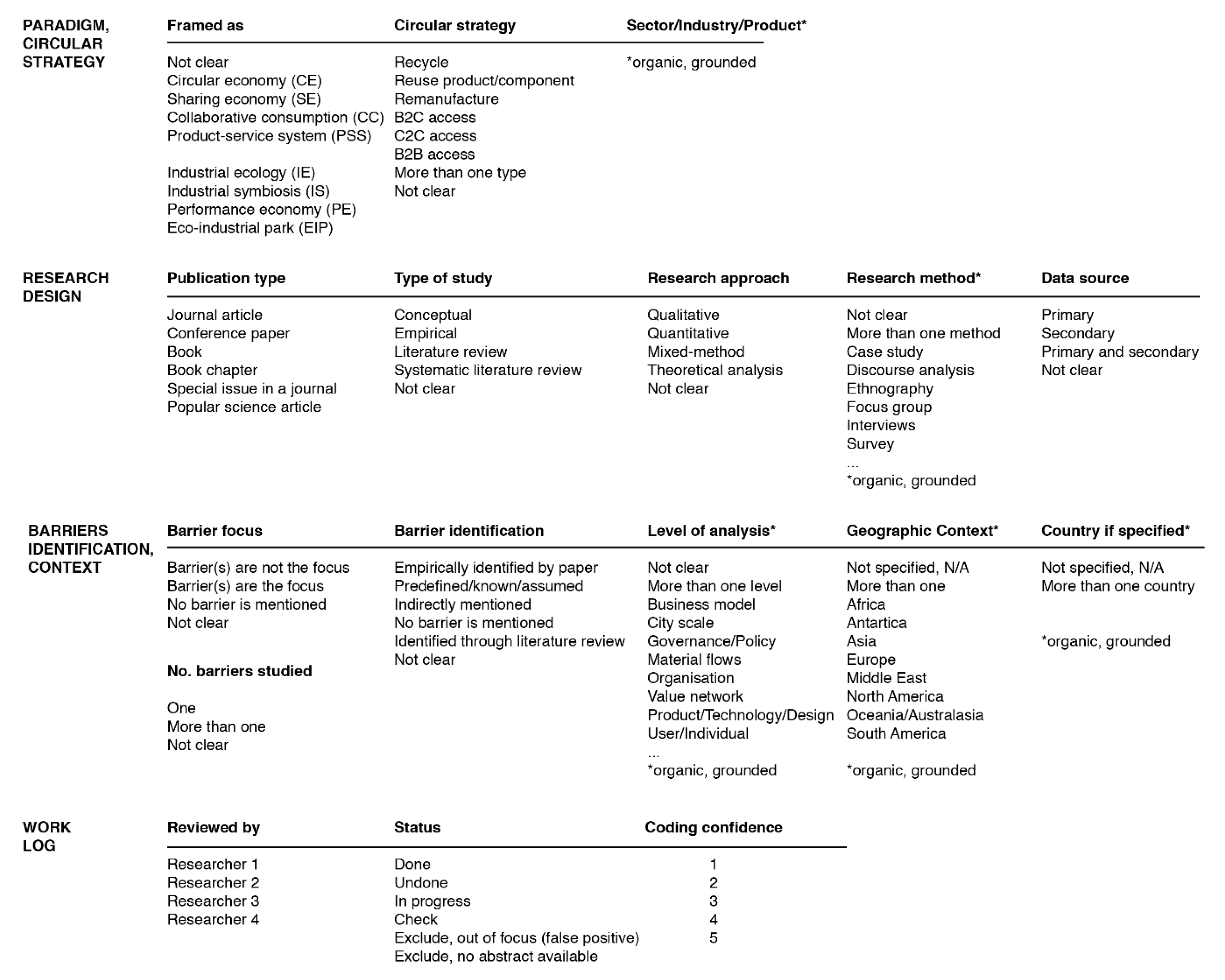



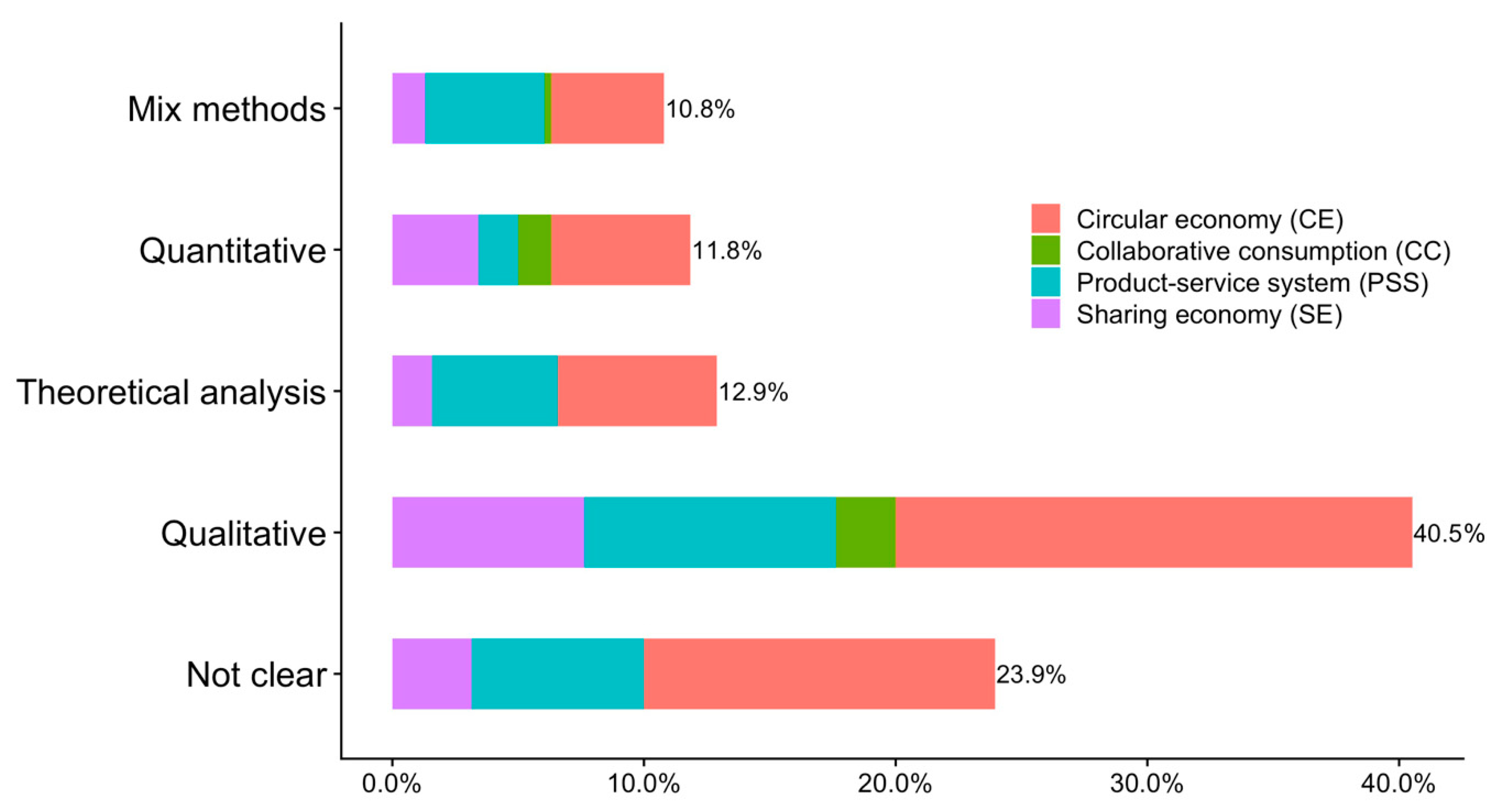
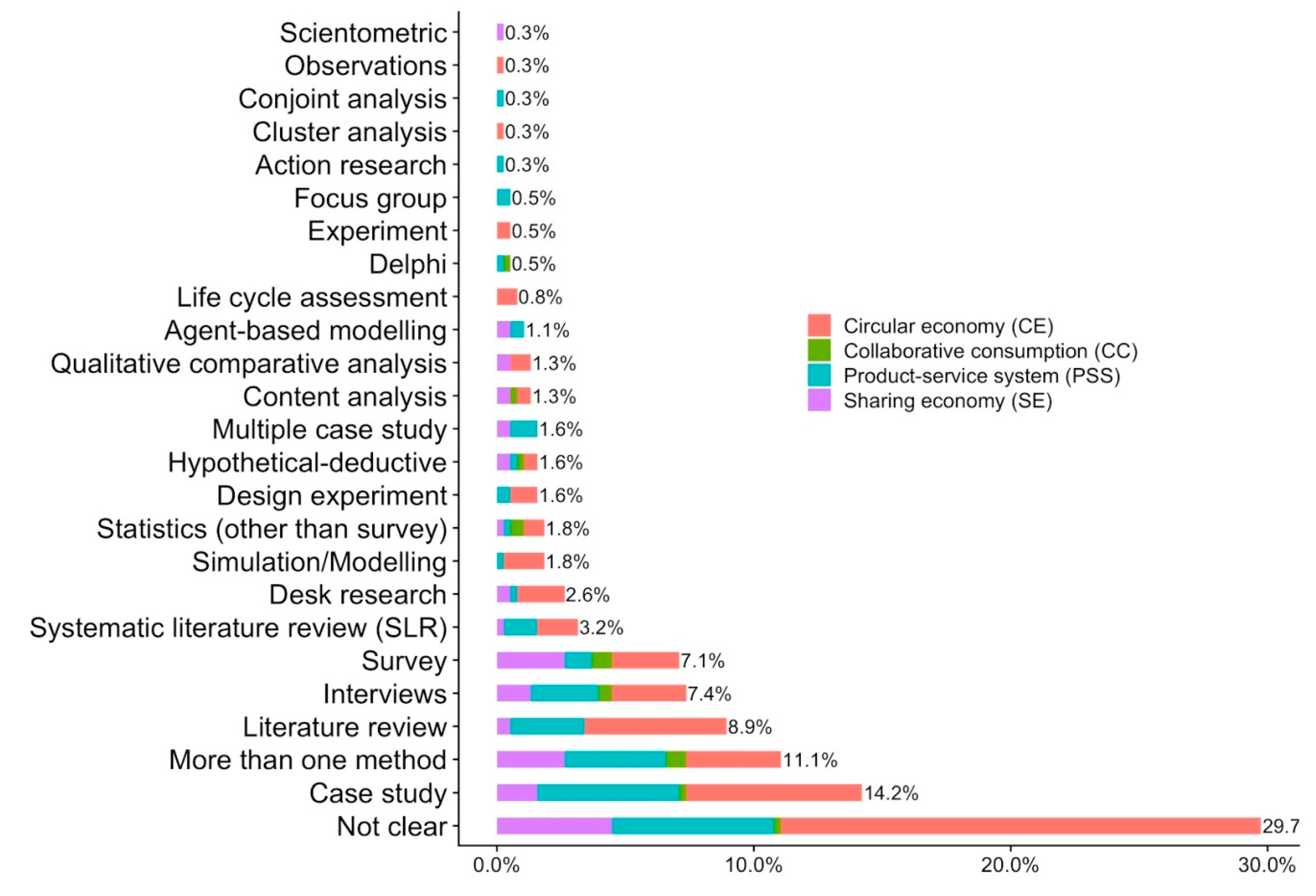
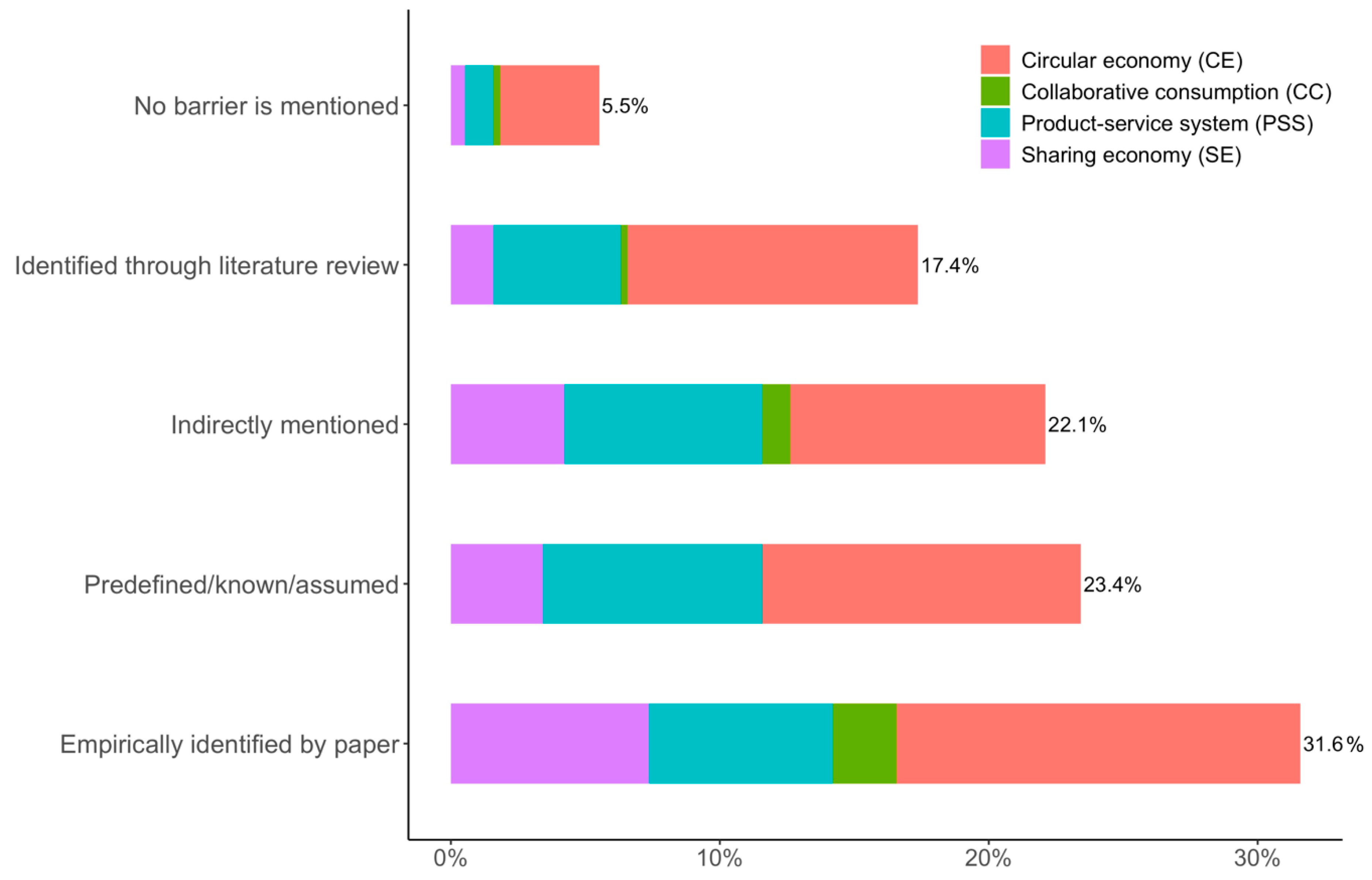

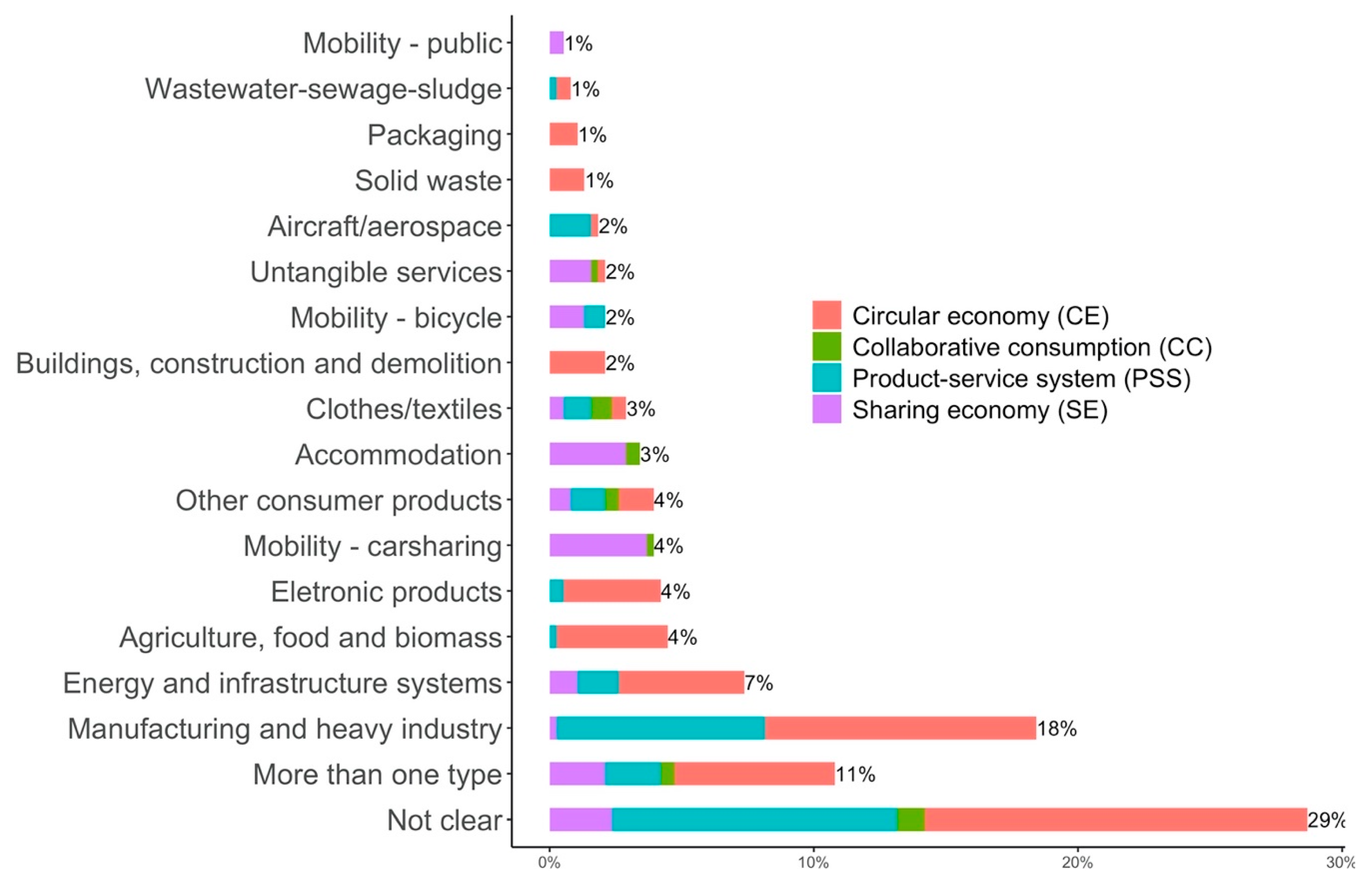
© 2020 by the authors. Licensee MDPI, Basel, Switzerland. This article is an open access article distributed under the terms and conditions of the Creative Commons Attribution (CC BY) license (http://creativecommons.org/licenses/by/4.0/).
Share and Cite
Sopjani, L.; Arekrans, J.; Laurenti, R.; Ritzén, S. Unlocking the Linear Lock-In: Mapping Research on Barriers to Transition. Sustainability 2020, 12, 1034. https://doi.org/10.3390/su12031034
Sopjani L, Arekrans J, Laurenti R, Ritzén S. Unlocking the Linear Lock-In: Mapping Research on Barriers to Transition. Sustainability. 2020; 12(3):1034. https://doi.org/10.3390/su12031034
Chicago/Turabian StyleSopjani, Liridona, Johan Arekrans, Rafael Laurenti, and Sofia Ritzén. 2020. "Unlocking the Linear Lock-In: Mapping Research on Barriers to Transition" Sustainability 12, no. 3: 1034. https://doi.org/10.3390/su12031034
APA StyleSopjani, L., Arekrans, J., Laurenti, R., & Ritzén, S. (2020). Unlocking the Linear Lock-In: Mapping Research on Barriers to Transition. Sustainability, 12(3), 1034. https://doi.org/10.3390/su12031034








